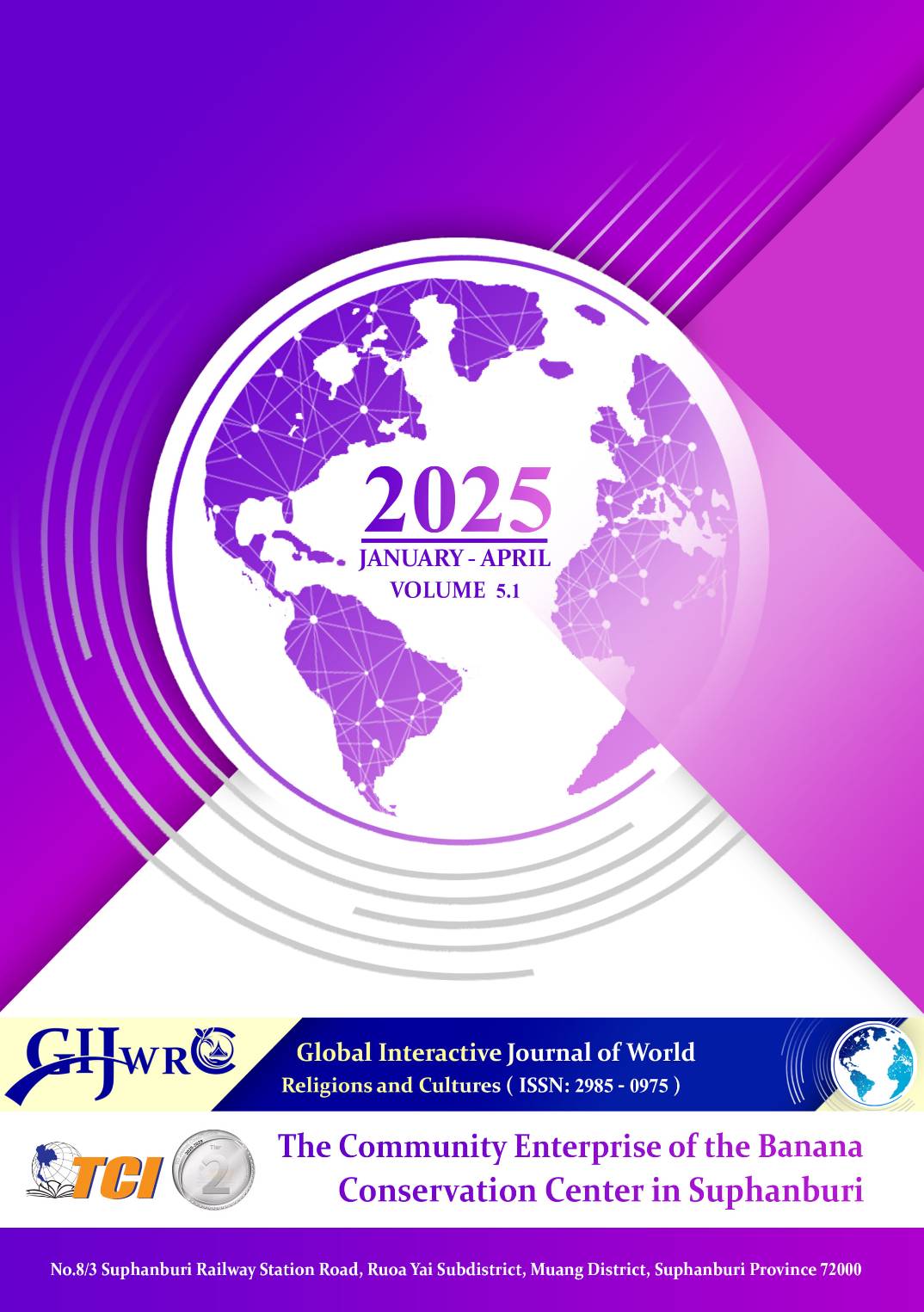THE USAGE OF WEARABLE TECHNOLOGY FOR MODERN AND LEARNING SOCIETIES: A STRUCTURAL EQUATION MODELING APPROACH IN WENZHOU, CHINA
Main Article Content
Abstract
This mixed-method research aims to study the key success factors of the wearable device industry in Wenzhou, analyze and apply the possible key success factors and the structural equation modeling of the wearable device industry in Wenzhou, China. The research instruments are questionnaire for quantitative part, and in-depth interview form for qualitative part. Data collecting from 400 respondents and 6 CEOs and executives of leading wearable technology companies in Wenzhou. The results reveal that the integration of wearable technology in modern and learning societies has transformed to digital environments, education, healthcare, and smart city ecosystems. The model identifies three primary independent variables: technological factors (TF), market-related factors (MF), and socio-cultural factors (SF), which contribute to key success factors (KSF) in wearable technology adoption. The SEM equation, KSF = 0.324TF + 0.547MF + 0.572*SF; R² = 0.794, confirms that socio-cultural influences play the most significant role, followed by market-related and technological factors. These findings suggest that understanding consumer preferences, branding strategies, and product differentiation is critical for the widespread adoption and sustained success of wearable devices in China’s evolving digital landscape. The qualitative insights gathered from six CEOs and executives of leading wearable technology companies in Wenzhou reinforce these quantitative findings that are the demand for health-tracking features integrated with AI and real-time monitoring to support China’s smart city initiatives, to improve battery life and seamless IoT connectivity, in enhancing user experience, to distribute networks in expanding into tier-2 and tier-3 cities, and integrating wearable healthcare applications with medical monitoring systems to support China’s aging population and those with chronic illnesses. The study’s findings highlight the growing role of wearable technology in modern societies, particularly in education, healthcare, and smart city applications. In learning societies, wearable devices enhance interactive education by enabling real-time progress tracking, biometric feedback, and AI-driven personalized learning experiences. The smart city framework benefits from wearables through contactless payment systems, mobility tracking, and safety enhancements. Therefore, the research results help to create a modern learning society by using wearable technology.
Article Details
References
Afrouz, M. M., and Wahl, T. (2019). ‘Watch Out’ for Wearables – Factors that influence the purchase intention of smartwatches in Germany. Thesis of Mater Degree Project, Jonkoping University.
Ajakwe, S.O. et al. (2016). Key Wearable Device Technologies Parameters for Innovative Healthcare Delivery in B5G Network: A Review. IEEE Access (4): pp. 1-21.
Amdan, L. (2021). Evaluation of Socio-Cultural Factors Influencing Consumer Buying Behavior of Clothes in Borno State, Nigeria. International Journal of Basic & Applied Sciences 1(3) pp. 519-529.
Aslam, A. et al. (2018). Globalization Helps Spread Knowledge and Technology Across Borders. Retrieved from https://www.imf.org/en/Blogs/Articles/2018/04/09/globalization-helps-spread-knowledge-and-technology-across-borders.
Binyamin, S., & Hoque, R. (2020). Understanding the drivers of wearable health monitoring technology: An extension of the unified theory of acceptance and use of technology. MOPI 12(9605) pp. 1-20.
Canhoto, A.I. (2017). Exploring the factors that support the adoption and sustained use of health and fitness wearables. Journal of Marketing Management, 33(1-2), 32-60.
Choi, B., Hwang, S., & Lee, S. (2017). What drives construction workers’ acceptance of wearable technologies in the workplace? Indoor localization and wearable health devices for occasional safety and health. Automation in Construction, 84, pp. 31-41.
Dunne, N. Dispensing with Indispensability. (2019). Law, Society, Economy Working Papers. London School of Economics & Political Science.
El-Masri, M., Al-Yafi, K., & Kamal, M.M. (2022). A Task-Technology-Identity Fit Model of Smartwatch Utilization and User Satisfaction: A Hybrid SEM-Neural Network Approach. Information Systems Frontiers 25:835-852.
Jiang, Y. et al. (2023). Review of China’s Online Education Policy, 1999-2022. ECNU Review of Education 6(1) 155-182.
Kao, Y.S. et al. (2019). An Exploration and Confirmation of the Factors Influencing Adoption of IoT-Based Wearable Fitness Trackers. International Journal of Environmental Research and Public Health 16(3227) pp. 1-31.
Khakurel, J., Porras, J, and Melkas, H. (2018). Tapping into the Wearable Device Revolution in the Work Environment: A systematic review. Information Technology and People 06:55.
Kornmai, C. (2018). Factors Affecting Attitude and Intention to Use Wearable Devices of People in Bangkok. Master of Business Administration, Bangkok University.
Krishnan, G. and Narayanamurthy, G. (2022). Determinants of the Adoption of Wearable Devices for Health and Fitness: A Meta-Analytical Study. Communications of the Association for Information Systems pp. 555-590.
MartketsandMarkets. (2021). Wearable Technology Market Size, Share & Industry Growth Analysis by Product, Type, Application, and Geography – Global Growth Driver and Industry Forecast to 2026. Retrieved from https://www.marketsandmarkets.com/Market-Reports/wearable-electronics-market-983.html.
Mckinsey & Company. (2016). Digital Globalization: The New Era of Global Flows. McKinsey Global Institute: London.
Meier, D.Y. (2019). Influence of Cultural Factors on Wearable Technology Acceptance in Healthcare: An Empirical Study with Chinese and Swiss Consumers. Zurich University of Applied Science (ZHAW).
Melanson, D. & Gorman, M. (2012). Our augmented selves: The promise of wearable computing. Engadget.
Niknejad, N. et al. (2019). A confirmatory factor analysis of the behavioral intention to use smart wellness wearables in Malaysia. Universal Access in the Information Society. Retrieved from https://doi.org/10.1007/s10209-019-00663-0.
Parida, D.K. (2020). Digital Marketing Strategy for Wearable Device Industry: Conceptual Framework. International Journal of Scientific & Technology Research 9 (4) 1363-1366.
Piwek, L., Ellis, D., Andrews, S., & Joinson, A. (2016). The Rise of Consumer Health Wearables: Promises and Barriers. PLoS Med., 13, e1001953.
Rabaai, A. & Zhu, X. (2021). Understanding the Determinants of Wearable Payment Adoption: An Empirical Study. Interdisciplinary Journal of Information 16: pp. 173-211.
Rodrigues, J. et al. (2018). Enabling Technologies for the Internet of Health Things. IEEE Access 2789329: pp. 1-13.
Sagmanli, S. (2022). An Investigation of Consumer Engagement with the Internet of Things in the Context of Smart Meter In-Home Displays. Thesis for the degree of Doctor of Philosophy, the Strathclyde Business School.
Statista. (2022). Wearable unit shipments worldwide from 2014 to 2021 (in millions). Retrieved from https://www.statista.com/statistics/437871/wearables-worldwide-shipments/.
Zhong, H. (2024). Education Modernization in Rural China: Expanding Temporality in Education Policy. Routledge 45(4), pp. 536-552.
Zhu, Y. (2019). New National Initiatives of Modernizing Education in China. ECNU Review of Education 2(3), pp. 353-362.


